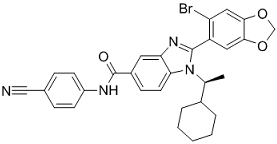
AZ3451 is a potent PAR2 (protease-activated receptor-2) antagonist with IC50 of 23 nM, which plays a part in inflammation response, apoptosis, autophagy and cellular senescence during Osteoarthritis (OA). AZ3451 prevents the IL-1β-induced inflammation response, cartilage degradation and premature senescence in chondrocytes.
In vivo, intra-articular injection of AZ3451 can ameliorate the surgery induced cartilage degradation in rat Osteoarthritis (OA) model.
| Cell Experiment | |
|---|---|
| Cell lines | chondrocytes |
| Preparation method | Primary rat chondrocytes are derived from the knee joint cartilage tissue of 1-week-old Sprague–Dawley rats. Cartilage pieces are sequential digested with 0.2% trypsin and 0.25% collagenase II dissolved in Dulbecco’s Modified Eagle Medium (DMEM) culture medium. The released chondrocytes are collected and cultured in DMEM supplemented with 10% fetal bovine serum (FBS), 100 units/ml penicillin and 100 μg/ml streptomycin. Up to approximately 80% confluences, cells are treated with 10 μM AZ3451 in the presence or absence of 10 ng/mL IL-1β. Passages 1–3 chondrocytes are used in our experiment to avoid the phenotype loss. |
| Concentrations | 10 μM |
| Incubation time | 48 h |
| Animal Experiment | |
|---|---|
| Animal models | male 8-week-old Sprague-Dawley rats |
| Formulation | dissolved in physiological saline |
| Dosages | 100 μl (50 μg/ml) |
| Administration | intra-articular injection |
| Molecular Weight | 571.46 |
| Formula | C30H27BrN4O3 |
| CAS Number | 2100284-59-9 |
| Solubility (25°C) | DMSO ≥ 80 mg/mL |
| Storage |
Powder -20°C 3 years ; 4°C 2 years In solvent -80°C 6 months ; -20°C 1 month |
| Species | Mouse | Rat | Rabbit | Guinea pig | Hamster | Dog |
| Weight (kg) | 0.02 | 0.15 | 1.8 | 0.4 | 0.08 | 10 |
| Body Surface Area (m2) | 0.007 | 0.025 | 0.15 | 0.05 | 0.02 | 0.5 |
| Km factor | 3 | 6 | 12 | 8 | 5 | 20 |
| Animal A (mg/kg) = Animal B (mg/kg) multiplied by | Animal B Km |
| Animal A Km |
For example, to modify the dose of Compound A used for a mouse (20 mg/kg) to a dose based on the BSA for a rat, multiply 20 mg/kg by the Km factor for a mouse and then divide by the Km factor for a rat. This calculation results in a rat equivalent dose for Compound A of 10 mg/kg.
| Related PAR Products |
|---|
| TRAP-6 amide
TRAP-6 amide is a PAR-1 thrombin receptor agonist peptide. |
| Protease-Activated Receptor-1, PAR-1 Agonist
Protease-Activated Receptor-1, PAR-1 Agonist is a selective proteinase-activated receptor1 (PAR-1) agonist peptide. |
| FSLLRY-NH2
FSLLRY-NH2 is a protease-activated receptor 2 (PAR2) inhibitor. |
| iso-TRAP-6
iso-TRAP-6 (iso-SFLLRN) is a PAR-1 agonist that can activate platelets. |
| PAR-4 Agonist Peptide, amide
PAR-4 Agonist Peptide, amide (PAR-4-AP; AY-NH2) is a proteinase-activated receptor-4 (PAR-4) agonist, which has no effect on either PAR-1 or PAR-2 and whose effects are blocked by a PAR-4 antagonist. |


Products are for research use only. Not for human use. We do not sell to patients.
© Copyright 2010-2023 AbMole BioScience. All Rights Reserved.
